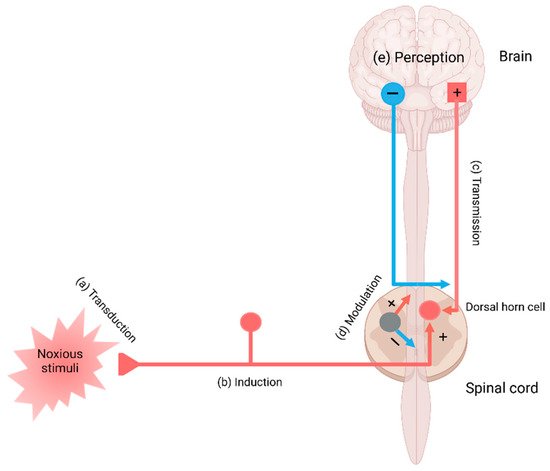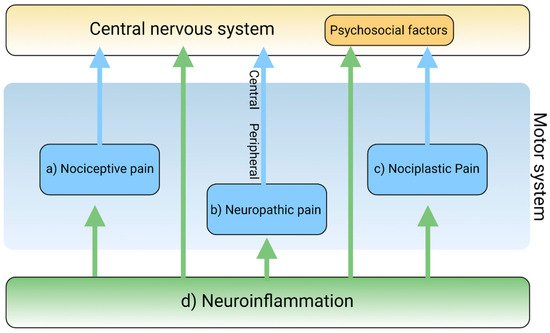Chronic pain is an unpleasant sensory and emotional experience that persists or recurs more than three months and may extend beyond the expected time of healing. Chronic pain occurs as a part of symptoms due to an underlying medical condition or remains despite successful treatment of the condition that originally caused it.
1. Introduction
Chronic pain occurs as a part of symptoms due to an underlying medical condition or remains despite successful treatment of the condition that originally caused it [1]. Chronic pain frequently becomes the sole or predominant clinical complaint [2]. The prevalence of chronic pain estimates as much as 20%, and the incidence reaches about 10% every year of the world adult population [3]. Nearly 10% of individuals with chronic pain was found to suffer from moderate to severe debilitating pain [4]. Furthermore, individuals with severe chronic pain are twice more likely to die of respiratory disease or heart disease than those with mild pain or without pain [3]. The Global Burden of Disease Research ranked low back pain and migraine first and second place of Years Lived with Disability (YLD), respectively, and thus, chronic pain imposes a substantial socioeconomic burden directly and indirectly on society [5].
The International Classification of Diseases, Eleventh Revision (ICD-11), classifies chronic pain into primary and secondary. Primary chronic pain is fibromyalgia or low-back pain; the secondary chronic pain occurs secondary to an underlying medical condition subcategorizing into cancer-related, post-trauma, neuropathic, headache and orofacial, visceral, and musculoskeletal pain. ICD-11 offers minimal options for recording psychological or social factors in chronic pain [6]. Meanwhile, the Diagnostic and Statistical Manual of Mental Disorders, 5th Edition (DSM-5) recognizes chronic pain in the diagnosis of somatic symptom disorder (SSD), having replaced pain disorder, a condition with chronic pain due to psychological factors [7]. SSD is caused by somatosensory amplification, which is associated with fibromyalgia [8]. The trend toward a neurological explanation obviously discounts cognitive, emotional, and social dimensions in the pathomechanism of chronic pain. Hyperalgesia is a condition of abnormally increased sensitivity to pain caused by injury to tissues or nerves. Nociceptive sensation is also caused by exposure to opioids used for pain treatment, which paradoxically makes individuals more sensitive to certain stimuli. Hyperalgesia is a challenging issue for pain specialists who treat patients at terminal care [9]. Chronic pain is often elicited by stimuli that previously did not provoke discomfort sensation. It is called allodynia. Allodynia is commonly observed in patients with neuropathies, fibromyalgia, migraine, complex regional pain syndrome, and postherpetic neuralgia [10]. Chronic pain may proceed to clinical conditions accompanied often by mood alterations, such as depression, anxiety, anger, cognitive disturbance including memory impairment, sleep disturbances, fatigue, loss of libido, and/or disability, called chronic pain syndrome (CPS). CPS appears to be linked to the dysfunction of the hypothalamic–pituitary–adrenal axis and the central nervous system (CNS), but exact mechanisms remain unknown [11].
Neuroinflammation has been intricately linked to the pathogenesis of chronic pain. Chronic pain was proposed to be caused by the disturbance of peripheral nociception, neuropathy in the somatosensory system, motor system, central and peripheral nociplasticity, and/or psychosocial system [12]. Increasing evidence suggests that chronic inflammation is strongly tied to aberration in each mechanism of chronic pain. Furthermore, the tryptophan (TRP)–kynurenine (KYN) pathway and its metabolites were observed to play an important role in neuroinflammation and chronic pain [13].
2. The Pain Pathway, Mechanisms, Neuroinflammation, and Tryptophan Metabolism
Pain perception is signaling through the pain pathway, whose components consist of transduction, conduction, transmission, modulation, and perception. Transduction is the process by which noxious or potentially damaging stimuli activate the nociceptors to convert to neural signals. Transmission refers to the signal transfer from the peripheral neurons to the second-order neurons in the spinal cord, which wire the signals to the thalamus and brain stem in the brain. Pain modulation takes place by inhibition of pain signaling in the spinal cord and the activation of the descending inhibitory fibers. The third-order neurons project to the somatosensory cortex, enabling the perception of pain. Perception is the subjective awareness in connection with arousal, physiological, and behavioral brain centers, involving the integration of psychological processes such as attention, expectation, and interpretation
[14][15][16] (
Figure 1).
Figure 1. The main components in the pain pathway: (a) transduction, (b) induction, (c) transmission, (d) modulation, and (e) perception. Created with BioRender.com.
Pain is a complex and intricate process attributable to nociceptic, neuropathic, and/or neuroplastic mechanisms. The most common type of pain is nociceptive pain caused by damage or potentially harmful to peripheral tissues involving nociceptors responsible for transduction. Neuropathic pain is caused by lesions or diseases affecting the somatosensory nervous system responsible for the transmission of peripheral to central pain signals. Nociplastic pain refers to the condition caused by altered nociceptive processing without actual or potentially harmful tissue damage activating peripheral nociceptors (nociceptive pain) or without lesions or diseases of the somatosensory nervous system (neuropathic pain). Cortical perception is one of the main components in the pain pathway; however, the ICD-11 excludes psychogenic pain
[17] (
Figure 2). Thus, participation of cortical perception in chronic pain mechanisms remains ambiguous.
Figure 2. The main mechanisms of pain and the involvement of neuroinflammation. The mechanisms of pain are classified into (a) nociceptive, (b) neuropathic, and (c) nociplastic pain. Neuroinflammation (d) is involved in each pain mechanism. Created with BioRender.com.
Inflammation is generally involved in the pathogenesis of various diseases and plays a key role in diseases that cause chronic pain
[18]. Resident and recruited immune cells release inflammatory mediators at peripheral nerve innervating damaged or inflammatory tissue to trigger action potentials in sensor neurons or sensitize neurons by increasing transduction and excitability. Inflammatory mediators also act directly on peripheral nerves to damage peripheral transmission
[19]. Immune cells infiltrate the spinal cord and the dorsal root ganglia to damage the central transmission and/or modulate pain sensitivity
[20]. Activated immune cells release inflammatory cytokines, chemokines, and other factors that influence cognition, mood, and behaviors through immune-to-CNS signaling
[14][21]. Accumulating evidence suggests that chronic dysregulation of the immune response is involved in the pathogenesis of psychiatric disorders such as mood disorders, substance abuse disorders, psychotic disorders, attention-deficit disorders, and autism spectrum disorders
[22][23][24] (
Figure 2).
Inflammation is invariably linked to the activation of TRP metabolism
[25][26]. The essential amino acid TRP is a precursor to serotonin, melatonin, and nicotinamide adenine dinucleotide (NAD
+), among others. More than 95% of TRP is metabolized through the TRP–KYN pathway, synthesizing various bioactive metabolites such as neuroprotective antioxidants and neuroprotectants, toxic oxidants and neurotoxins, as well as immunomodulators. The disturbance of KYN metabolites has been linked to immune disorders, cancers, neurodegenerative diseases, and psychiatric disorders
[27]. Furthermore, TRP–KYN metabolites are under extensive research in search of peripheral biomarkers as well as novel drug prototypes for a wide range of diseases
[28][29][30][31][32][33][34]. Inflammation activates the TRP–KYN pathway, elevating the levels of oxidative compounds or neurotoxic ligands to receptors of the excitatory glutamatergic nervous system, which damage the peripheral nervous system or CNS through the broken blood–nerve or blood–brain barrier, respectively
[14]. Furthermore, immunomodulators are known to trigger the shift of acute inflammatory status toward tolerogenic and chronic inflammation, perpetuating low-grade inflammation
[26][35]. KYN is synthesized from TRP by the tryptophan 2,3-dioxygenase (TDO) in the liver and the indoleamine 2,3-dioxygenases (IDOs) in the brain and the immune system, which are induced by cortisol, and interferon (IFN)-α, IFN-γ, and tumor necrosis factor (TNF)-α, respectively
[36]. Anthranilic acid (AA), 3-hydroxykynurenine (3-HK), or kynurenic acid (KYNA) are produced from KYN by the kynureninase (KYNU), the KYN-3-monooxygenase (KMO), or the kynurenine aminotransferases (KATs), respectively. The KATs also convert 3-HK to xanthurenic acid (XA). XA converts into cinnabarinic acid by autoxidation. AA and 3-HK convert into 3-hydroxyanthranilic acid (3-HAA) and then into picolinic acid and quinolinic acid (QA). QA converts into NADH, which is a feedback inhibitor of TDO
[29] (
Figure 3). Generally, 3-HK and QA are described as neurotoxic, while KYNA is considered to be neuroprotective. The 3-HK/KYNA ratio is often applied as an indicator of neurotoxicity. However, emerging evidence suggests that some metabolites of the TRP–KYN pathway possess Janus-face properties, depending on the dose or the situation. For example, KYNA is excitatory in lower concentrations but inhibitory in higher concentrations at α-amino-3-hydroxy-5-methyl-4-isoxazole propionic acid (AMPA) receptors. 3-HK is known to be an oxidant but observed to be an antioxidant in certain conditions
[25][37].
Figure 3. The tryptophan (TRP)–kynurenine (KYN) metabolic pathway and its metabolites. The pathway varies from the type of cells. Some enzyme is missing in some cells, not producing some metabolites. The TRP–KYN metabolic pathway synthesizes various metabolites, including oxidants (orange color), antioxidants (green color), and immunomodulators (blue dotted line). TDO: tryptophan 2,3-dioxygenase; IDO: indoleamine 2, 3-dioxygenase; KYNU: kynureninase; KMO: kynurenine-3-monooxygenase; KATs: kynurenine aminotransferases.
The stress hormone cortisol, the strong immune activator lipopolysaccharide, proinflammatory cytokines, positive feedback loops, diminished levels of antioxidant system enzyme superoxide dismutase, and anti-inflammatory cytokines all lead to the potentiation of the TRP–KYN pathway
[26]. Furthermore, the action of the KYN enzymes and metabolites are complicated by the interactions with adjacent biosystems such as the oxidative stress complex, the antioxidant enzyme systems, the serotonin neurotransmission, the glutamate neurotransmission, the tetrahydrobiopterin pathway, the cannabinoid system, and the aryl hydrocarbon receptor signaling
[26][37].
3. Conclusions and Future Perspective
Chronic pain arises through a complex pathogenic process involving more components and developing into the pain continuum. Central sensitization, peripheral sensitization, and somatization are pathogenic processes of pain development in the pain continuum spanning components of the pain pathway and the pain mechanism, which is hardly understood without the presence of the cortical perception. The nociplastic mechanism of pain attempts to delineate pain without relevant cause or lesions of the somatosensory nervous system, such as altered perception of nociception. Chronic pain presented in fibromyalgia syndrome, chronic back pain, and complex regional pain syndrome is best understood in the framework of pain perception, including cognitive, emotional, and social components. Chronic pain experienced in psychiatric conditions, in particular, is not fully explainable in the view of the nociplastic pain mechanism. Pain sensation is developed through complex interactions with higher cortical centers governing mood, emotion, and cognition.
More and more emerging findings shed light on the relationship between psychiatric symptoms and networks of the brain centers in neuropsychiatric disorders [38][39][40]. Stimulus-evoked functional magnetic resonance imaging (fMRI), task-free fMRI, and perfusion MRI revealed that chronic pains arise from pre-existing vulnerabilities and sustained abnormal input [41]. Neuroimaging techniques, including fMRI and positron emission tomography, may open the gate to understanding underlying mechanisms in signaling to the third-order neurons to the cortex in chronic pain sensation [42][43][44]. Pain relief can be achieved through accompanying symptoms such as cognition, mood, and sleep by pharmacotherapy and/or psychotherapy [42][45][46][47]. Therefore, psychogenic components of pain play an essential role in understanding the pathomechanism of chronic pain unless the nociplastic pain mechanism can sufficiently elucidate the reciprocal interaction with third-order neurons in the pathogenesis of chronic pain.



